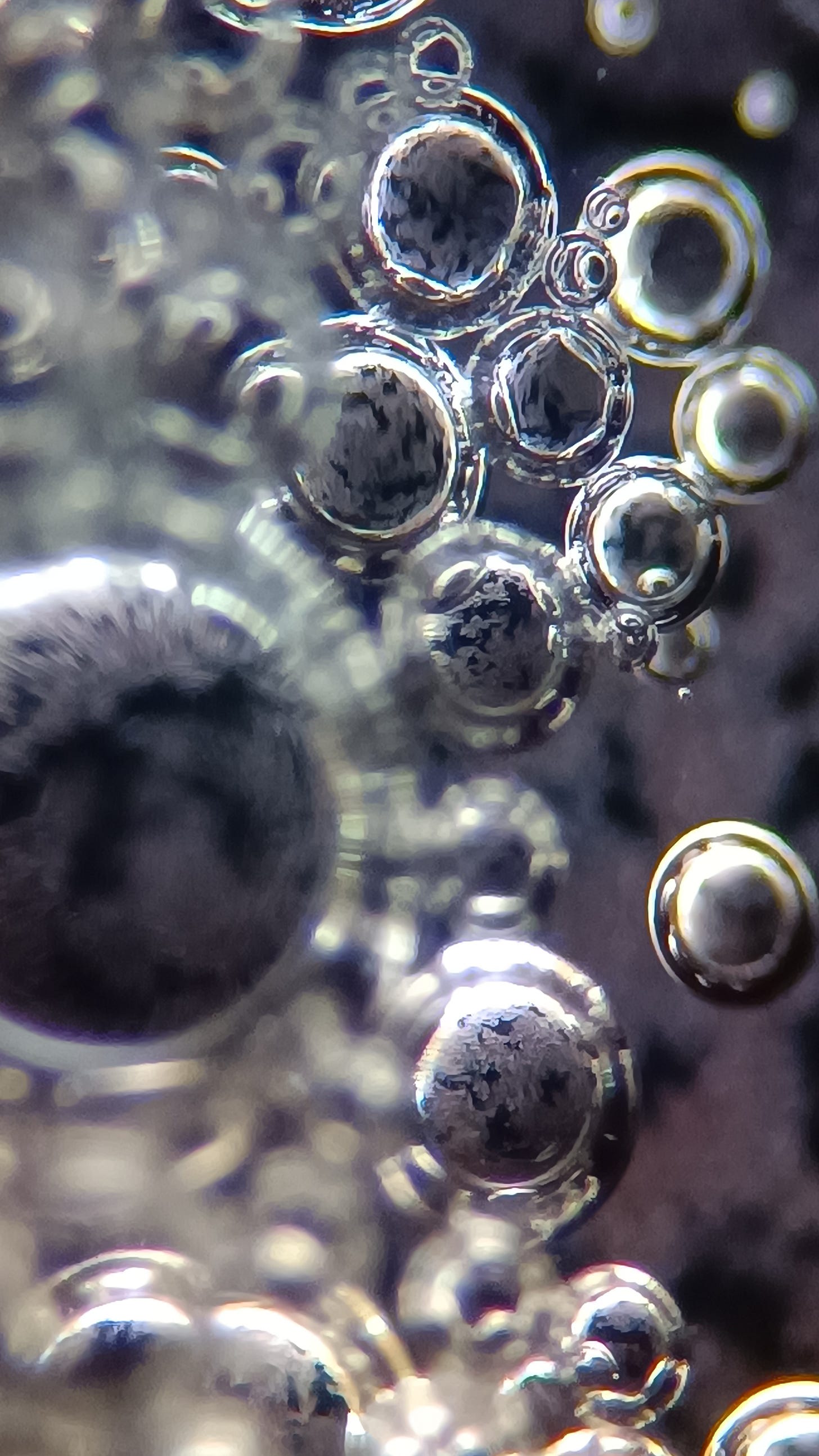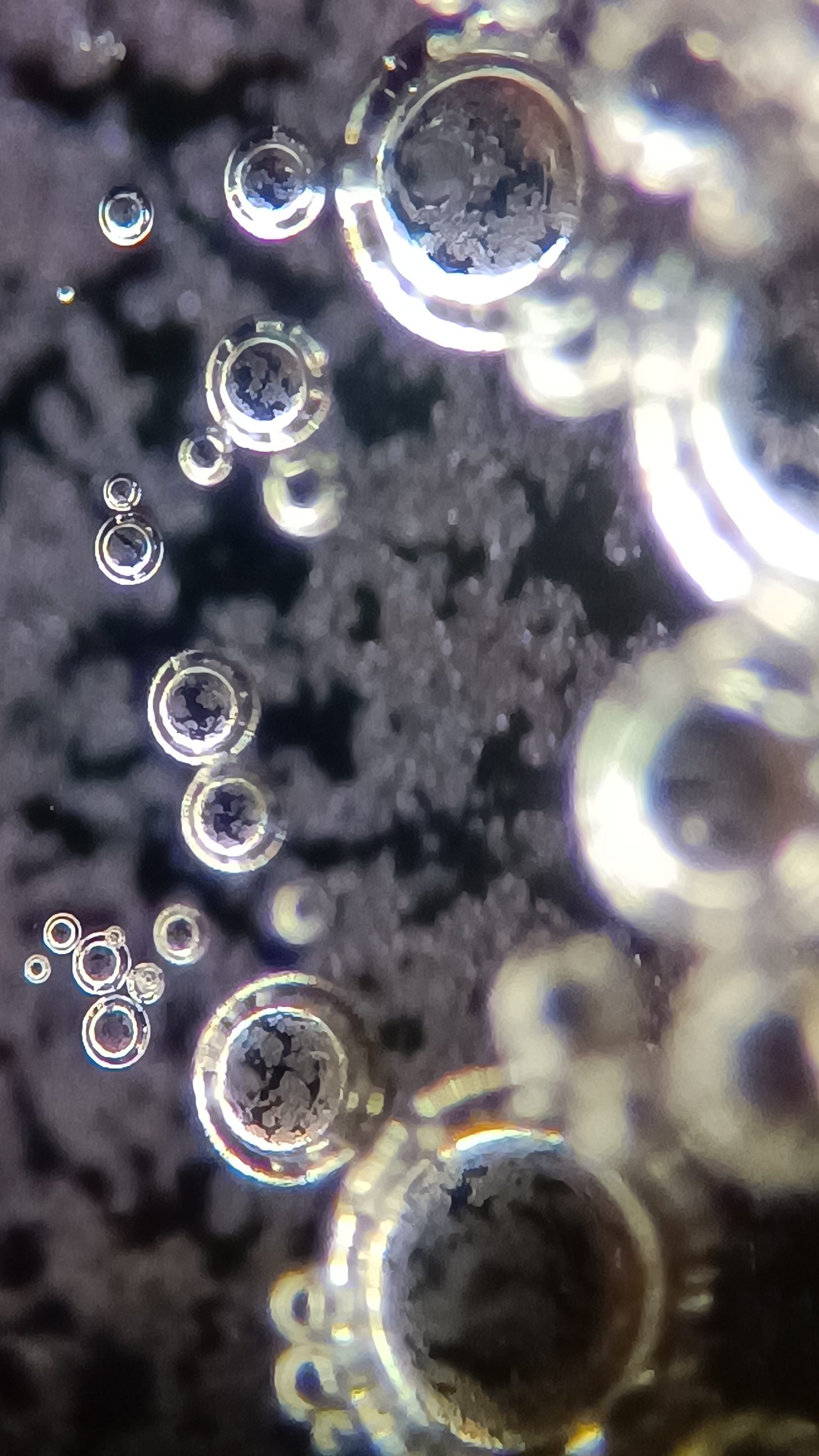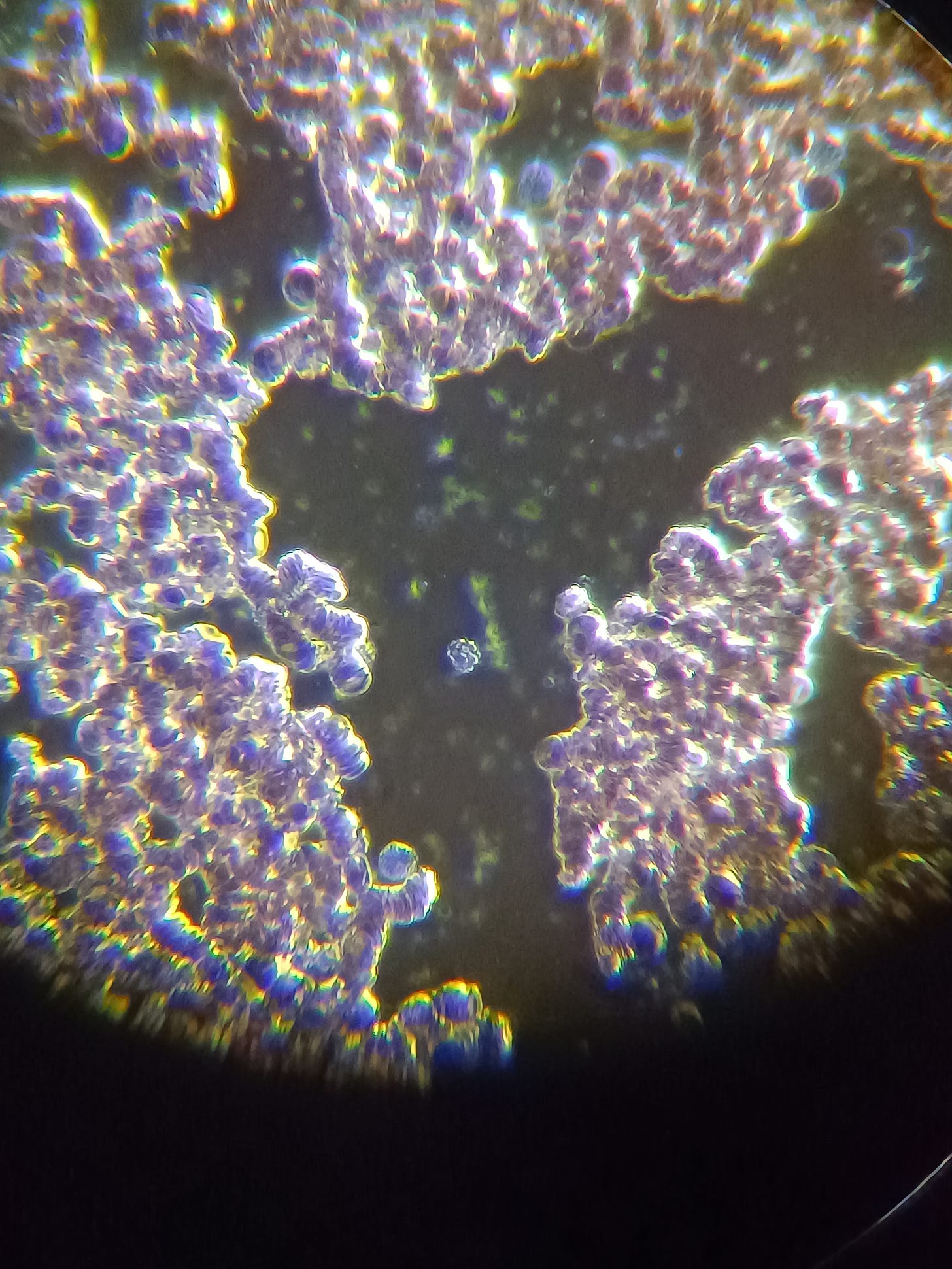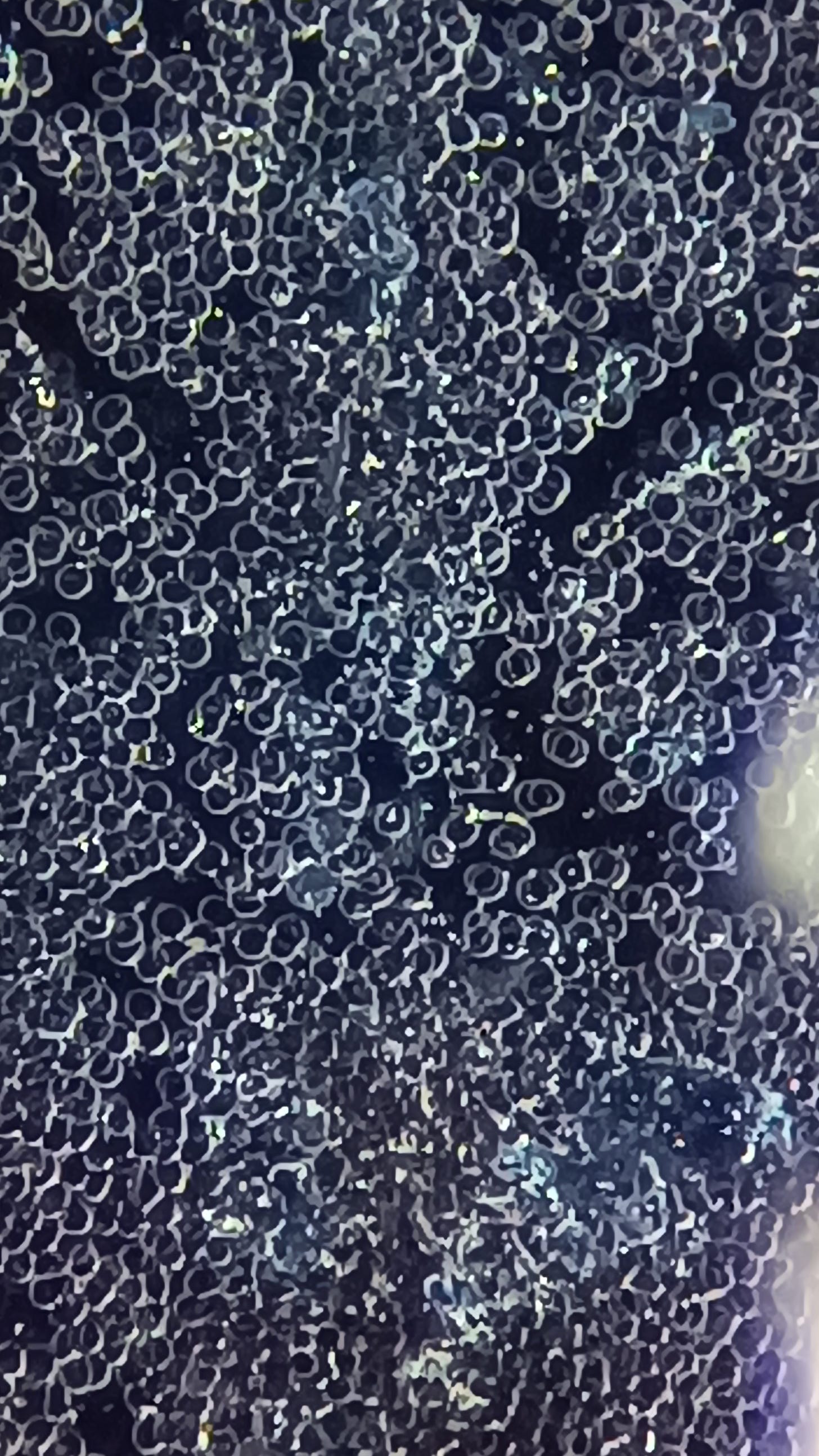As I am now down to the one thing I trust it seemed appropriate to do a deeper dive and show what the bloods reaction is to an application of 1.5% peroxide directly onto fresh blood. Now I am even happier to imagine the effect its having when I inhale it as I now envisage this reaction entering the bloodstream via the pulmonary alveolus. ( not a doc, so hope I got that right).
Sparkly. It initially over ran the coverslip.
Haven’t looked at my blood for a while and got a pleasant surprise. Since stopping all supplements after looking at the vitamin C, it is the best I’ve seen for ages. Still applying, drinking and inhaling peroxide though. Considering 60+ yrs, 50 as a heavy smoker (still, real tobacco not the dyed cardboard things) , largely meatarian plus fruit, eating one meal a day , moderate drinker (NZ Marlborough savs only), I cant complain.
When you first drop the cover slip on, the blood runs out under the slip onto the slide. For quite a while my blood has had rouleaux by the time I looked. Today it took a lot longer. Also, I didn’t realize until after that I had only seen one suspected morg where I usually see 5 < 8 clear ones at least.
First I let the blood coagulate and rouleaux a bit. Approximately 25 minutes. Not my finest microscopy but you get the picture.
X40 x15 x 10
Then I added a drop of 1.5% peroxide beside the cover slip and let it work its way into the gummy blood. the first thing I noticed was the clarity and the amount of separation between the RBC’s.
Even in the central areas that had coagulated rouleaux. X40 x15 x10.
Even the RBC’s that had started to beak down looked better.
Sorry, bumped the chair. I am human not A.I.
Art pieces, blood through a peroxide lens
Gluggy rouleaux.
Peroxide does make the blood sparkle.
Just my personal experience. Not medical advice . Don’t snort 6% peroxide. Blah , Etc.
Also looking forward to Mondays post. It will probably be my last for a week or so. got some work to do. After that will be a report from the conference in NZ, with lots of testing results.










Not being a wet blanket, but a caution. As with anything that kills anything, safety is primary.
Hydrogen Peroxide doesn't just kill virus/bacteria. It also kills anything it's applied to. Meaning the cells of your body as well. It doesn't and can't discriminate between what you want to kill and what you don't.
That being said, the body can rapidly convert hydrogen peroxide and break it down but only at a certain rate of breakdown. That's why the concentration of H2O2 is important. If too much or too strong a solution is used of H2O2 it overwhelms the body's ability to break it down and the H2O2 continues killing everything until it is broken down. How long does it take to break H2O2 down? That all depends on your body and the amount of H2O2 and strength of solution.
The body breaks H2O2 into parts. One of them being oxygen. Oxygen is a gas.
If you inject H2O2 into your body it's converted into its parts as quickly as the cells of the body can in order to stop it from killing. But the oxygen gas is gas inside your bloodstream. Gas bubbles. Of air.
You can kill someone by injecting air, H2O gas, into their bloodstream since the gas bubbles will interfere with blood flow and can cause blood clots or an embolism (air bubble) which can travel to the heart and disrupt its pumping causing a heart attack or to the brain causing a brain embolism.
Blood clots can travel and cause the same harm.
So, when you observe the slides of the blood cells looking "shiny and happy", they are actually being broken down by the H2O2. That's it's job and why most hospitals have stopped using it as an antiseptic. I'm not "siding with hospitals" here. Only saying why they've stopped using it and use antibiotics instead since those do target and kill only bacteria, not healthy body cells.
My guess is H2O2 is breaking the rouleaux cells apart because it's breaking the entire cell down and it starts from the outside. What kind of damage does H2O2 do to the rest of the cell as it breaks the rouleaux apart? Idk.
When you see the slides of cellular interaction on the skin, it's not only Morgellons or nanos it's killing, it's also skin cells it's killing. That may be why some reactions on some people are more dramatic than others since each individual reacts differently. Some individuals skin cells may break the H2O2 down faster than others do.
I'm not sure this is proof there are no Morgellons or nanos on that individuals skin, only proof the H2O2 is neutralized and has stopped killing anything.
I'm just saying, before you inhale H2O2 or inject it or even apply it to your skin, know you are also killing healthy body cells in the pursuit of killing unwanted invaders.
I am not pooh-poohing Matt's work here. I'm just giving a heads up to the precautions that need to be noted so no one enters into a therapy blindly without all the information (which Matt may have given in a previous post). Especially a therapy that can be harmful and result in death if improperly administered.
Also use caution when inhaling Iodine or Chlorine Dioxide, a bleach used by public water municipalities that most people strive to filter out and avoid drinking, both of which can cause not only irritation to the airway and lungs but pulmonary edema (or fluids) to fill the lungs and rapidly become an emergency and result in death. The same way pneumonia kills. Depending again on the amount and concentration of either and individual response.
Proceed with caution. Godspeed.
Matt - thank you for sharing your work, glad to hear H202 is working for you! food grade H202 is standing strong after all these years. I used to do an annual 21 day detox. Here's a bit of additional info for all the questions on H202 (I always get the high % and dilute it with distilled water). Including some old notes on food grade H202 / peroxide:
Concentration recognized by the FDA as safe to add to fish eggs in order to prevent fungal growth (Perox-Aid):
500 parts per million = 0.05%
Concentration that some peeps drink:
500 parts per million = 0.05%
Concentration used to “shock” a swimming pool:
875 parts per million = 0.0875%
Concentration (purported) of the healing water at
Lourdes: 2,500 parts per million = 0.25%
Foot soak using 3 gallons of water and one quart of 3%:
2,500 parts per million = 0.25%
Concentration of drinking water fed to experimental animals to successfully treat tumors:
4500 parts per million = 0.45%
Concentration often recommended by health practitioners in “purging” protocols:
5,000 parts per million = 0.5%
Concentration used by the “Birdman of Alcatraz”:
7,500 parts per million = 0.75%
Highest concentration given intravenously:
7,500 parts per million = 0.75%
Concentration approved by the FDA for mouthwash and gargle:
15,000 parts per million = 1.5%
Concentration approved by the FDA for topical application as a disinfectant on the skin:
30,000 parts per million = 3%